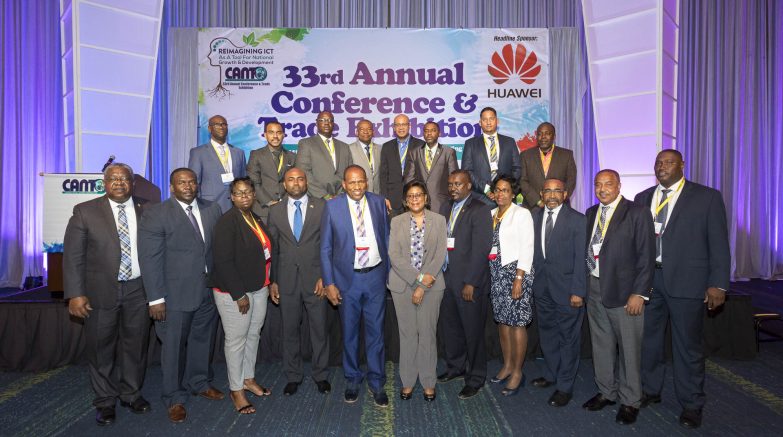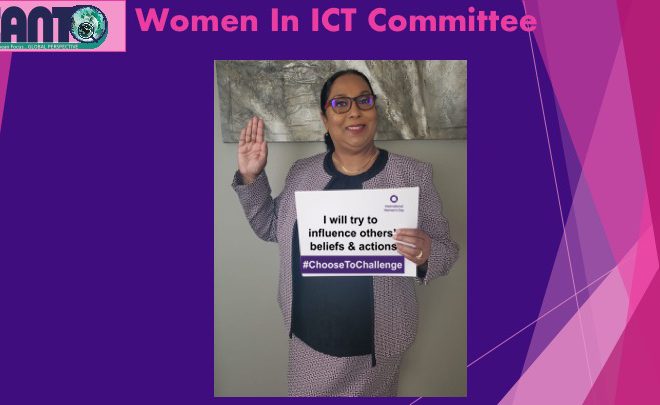CANTO WEEKLY NEWSLETTER – BNamericas
Thursday, August 9, 2018
| ICT: The week in 10 stories – Regional Liberty Latin America Reports Q2 and H1 2018 Results – Regional The Innovation Sandbox – Regional Panama, Mexico testing Estonia’s e-gov platform – Regional BigTechs unlikely to become banks… but telcos might – Chile, Regional |
| Our Mission “Influence the innovation and development of ICT solutions for the benefit of members by developing, navigating and leveraging relationships with all stakeholders.” “Advocate for policies, legislation and rules which advance the creation of an environment which facilitates the deployment of services and technologies around the region.” |
| Vision “To become the leading authority in shaping information, communication and technology in the Caribbean Region and the Americas.” |
| ICT: The week in 10 stories – Regional
Colombia’s finance ministry launched the sale of the government’s 32.5% stake in Colombia Telecomunicaciones (Coltel). Colombian MVNO Uff Móvil suspended operations on Friday, citing problems of unpaid debts with Millicom unit Tigo-Une. ARGENTINA Mendoza has become the first Argentine province to regulate ride-hailing service Uber. CHILE Telecoms regulator Subtel aborted a tender for the two remaining terrestrial tranches of the Fibra Óptica Austral (FOA) public-private partnership to connect the far south of the country, saying the four bids received did not meet legal, technical and economic specifications. Retail giant Falabella has acquired regional e-commerce site Linio for US$138mn. Linio operates in eight countries, including Mexico, Colombia, Peru, Argentina and Chile, with US$137mn in annual sales, according to Falabella. State development agency Corfo will request 2bn pesos (US$3.1mn) from the government for a tender to build three advanced manufacturing centers in the country, a move that is indicative of the country’s need to modernize and digitize the economy. DOMINICAN REPUBLIC Only about half of Dominican Republic users are “very satisfied” with the telecom services provided by operators, according to a poll conducted by regulator Indotel. BRAZIL The main obstacle to final approval of the merger between Time Warner and AT&T in Brazil is the country’s 2011 pay TV regulation, which prevents cross-ownership between programmers (content) and operators (media). PERU Though its speeds have fallen in recent months, Peru is still one of Latin America’s leaders in 4G coverage, according to the latest report from consulting company Open Signal. The study, based on data collected from April 1 to June 29, shows that Entel and Movistar led the speed race, clocking 17.19Mbps and 17.01Mbps, respectively. REGIONAL Amazon Web Services (AWS) is by far the dominant force in the cloud infrastructure market in Latin America, accounting for 45% of sales. Microsoft Azure comes a distant second with 18%. Liberty Latin America Reports Q2 and H1 2018 Results – Regional August 8, 2018 Q2 RGU Additions of 61,000 Driven by Record Broadband Gains Restoration of Puerto Rico On-Track; > 90% of Subscribers Billable Today Expanded Network Reach in Q2 with > 80,000 New / Upgraded Homes Financial guidance for 2018 confirmed Liberty Latin America Ltd. (“Liberty Latin America”) (NASDAQ: LILA and LILAK, OTC Link: LILAB) today announced its financial and operating results for the three months (“Q2”) and six months (“YTD” or “H1”) ended June 30, 2018. CEO Balan Nair stated, “Building on a solid start to the year, we added over 60,000 RGUs in the second quarter, including a record number of quarterly broadband additions. This result shows the potential for our fixed businesses, operating in markets where we believe there is additional demand for high-speed services. In mobile, we are seeing a growing number of subscribers using our LTE networks and we have introduced combo plans (with voice, data and text messages) across our markets to address consumers’ changing needs while also aiming to maintain and grow our revenue. We continue to invest in product offerings our customers demand, leveraging the capabilities of our mobile and fixed networks. For example, in addition to Flow-to-go, which we already provide in C&W’s markets, we recently launched VTR Play in Chile, and Go in Puerto Rico, which enable our customers to stream their favorite TV programs at home or on-the-go.” “Our Puerto Rican business delivered another solid quarter of sequential revenue and OCF2 growth, as we focused on being fastest to market, both in reconnecting existing customers and reaching new customers. Over 90% of our subscribers are now billable, and in Q2 we saw the first quarter of organic net additions since last year’s hurricanes with quarterly sales ahead of Q2 2017.” “We have been working for a number of years to design and implement a digital transformation strategy at VTR and I’m excited to announce that this is now being rolled-out. As a result, our customers will benefit from faster and more effective service delivery, which we expect will differentiate us from our competitors and also drive cost efficiencies in our business as we refine our processes. There is tremendous potential to leverage this platform and the learnings from our Chilean business across Liberty Latin America.” “In-line with our expectations, we have continued to expand and improve our fixed networks in 2018, with over 160,000 homes upgraded or added in the first half of the year. We are also investing in high-speed LTE mobile networks, which we anticipate will drive usage and ultimately revenue.” “In our first six months as a separately listed company, we have made significant strides towards creating the culture, structure and platforms required for sustainable future growth and we remain on-track with our 2018 guidance1 targets.” Q2 Business Highlights • C&W operating momentum building: 29,000 fixed organic RGU additions supported by product and service enhancements Continued network upgrade and expansion added over 40,000 premises in Q2 B2B revenue growth driven by sub-sea networks and managed services • VTR continued to deliver solid growth: Reported rebased revenue growth of 5% and rebased OCF growth of 7% Broadband RGU additions of 27,000, best quarterly performance in two years Launch of “VTR Play”, with up to 80 channels available to stream on-the-go • Liberty Puerto Rico close to fully operational: Service available to over one million homes First quarter of net organic RGU additions since Hurricanes Irma and Maria Launched “Go” video streaming application in early August For the full release click here The Innovation Sandbox – Regional By Lode Verdeyen, CEO Engie Factory What does a typical large company do when an important project fails? Answer: the quick and ruthless severance of one or more line-managers in order to set an example and stop the blame from reaching the top of the company. Should the company act in the same way in the case of an innovation project? There are innovation projects with little risk, such as the purchase and implementation of an innovative but commercially proven technology with little uncertainty and a high probability of success. Conversely, the creation and marketing of a new product in a new market, far from the core business, will probably not be successful the first time, if ever. It will definitely be necessary to improve the design, production and marketing of the product in several cycles. But these are exactly the kind of innovations that can generate extremely high returns. The process of reiterating, understanding what the important aspects are, optimizing the design and market requires patience and resources from the top management, and perseverance, creativity and energy on the part of the innovation project leader. For the company it is complicated to handle long processes with successive failures because it often goes against the reigning corporate culture. Progressive companies try to establish a culture that allows failure, launching for example an internal campaign with the idea to convince workers that it is alright to fail in innovation projects. Sometimes they implement a prize for the best failed idea. However, we have seen instances where this is not enough: a decades-old company culture cannot be undone with a single internal campaign. The instances where senior management punishes managers or workers who failed, in one way or another, do not encourage innovation; nobody with ambition is willing to take the risk of finishing her or his career prematurely. Enter the Innovation Sandbox The sandbox is a place where children play with sand and quickly shape their dreams with little effort. In addition, it is a safe area and the risk of injury is limited. The same concept is used in software development where, to test a new version of a program, tests are conducted in a limited and well-controlled environment; that is, in a sandbox. From these concepts, a new area is born that we call the Innovation Sandbox (or ISBX). A company that wants to encourage innovation of the risky and uncertain type, should create an ISBX. It is a space well isolated with impenetrable borders, so that the current culture and processes of the company do not rule within it. It is a bootcamp where one enters as a hero and emerges as a hero, independent of the outcome of the project. Within this ISBX, internal processes must operate at a much faster speed (10X, 100X) than in the rest of the company. This is of uttermost importance since the cycling is taking a lot of time, and the time to market is crucial. The incentives for the participants are shares in equity or a similar bonus scheme related to the creation of value. As a result, the rewards are potentially much larger than for other jobs in the company. The ISBX cannot depend on services provided by other areas of the company such as HR, accounting, procurement, logistics, marketing, etc. These support departments work well for the company’s core business, but they do not have the knowledge, contacts, culture and, especially, the speed needed to adequately support the ISBX. To obtain this specialized support, these services are contracted with external companies. In mature venture capital ecosystems, it is easy to find these specialized companies; however, in countries or regions with a poorly developed startup ecosystem, it can be a problem. (In relation to Latin America, the ecosystem in Chile is growing rapidly, with a lot of new companies providing specialized services; in other countries, such as Peru, they are not available yet but are likely to appear soon.) In the ISBX, projects are financed with internal or external capital, but according to the rules of venture capital: there are rounds of successive capital increases and, in the event that the available capital or the willingness to continue runs out, the project ends without scandal. It is essential that the innovator leaves with his reputation intact. Otherwise, which aspiring-innovator of the company will take the risk of being disposed of in a future project? Finally, the innovator who, after a failed project, dares to return to manage a new innovation project, will be better prepared with more motivation and resilience. Lode Verdeyen is CEO of Engie Factory, a corporate accelerator based in Santiago, Mexico City and Singapore. Engie Factory is itself an ISBX for the Engie group, accelerating and also investing in startups with sustainable products and/or services. DISCLAIMER: The content is entirely the responsibility of the author and does not necessarily reflect the views of Business News Americas. We encourage Guest Column pieces, and those interested in submitting one for possible publication should contact the editor at telecom@bnamericas.com. Panama, Mexico testing Estonia’s e-gov platform – Regional Panama and Mexico are the first Latin American countries to test the Estonian e-government platform X-Road, according to former Estonian president Toomas Hendrik Ilves. Ilves spoke Monday at the GovTechBr digital governance event in São Paulo, Brazil, where he outlined the presented the northern European nation’s progress over the last two decades in digitizing government processes . Estonia’s homegrown X-Road platform is considered the “backbone” of the country’s often praised digital government system. According to the UN’s latest index on e-government development, the small former Soviet nation is ranked 16th of 193 countries, with score of 0.846. Estonia claims that X-Road is the world’s first platform that allows data to be automatically exchanged between countries. Since June 2017, such automatic data exchange capability has been established between Estonia and its northern neighbour Finland. In addition to Estonia and Finland, X-Road has also been implemented in Azerbaijan, Namibia and the Faroe Islands. Originally, X-Road was used to send queries to different government databases (just like Brazil, Estonia has several of them) before later being developed into a tool that can also be use to write to multiple databases, transmit large datasets and perform searches across several databases simultaneously. Among other services, it is possible to vote, open and close businesses, request services, send documents and receive medical prescriptions in a single portal. A unique digital identity for each citizen authenticates the operations. “Technically, all that can be done in small countries could be scaled to larger countries,” Ives said. The former president says that digitalization generates annual savings of 2% GDP for the European country. The event also heard about the e-government cases of India and Uruguay. Like Estonia, Uruguay is also on the road to creating a unique digital identity for all of its citizens. Currently, 50% of all processes in the country can be initiated online by citizens and 20% of them can both be initiated and completed online, according to the head of Uruguayan e-government agency Agesic, José Clastornik. A law states that by 2020 all processes should be initiated and completed online in Uruguay. Uruguay is the best ranked Latin American nation in the UN e-government index, at 34th. In February, the country also joined a prestigious group of the seven most digitized nations. BigTechs unlikely to become banks… but telcos might – Chile, Regional Tech giants like Google, Amazon, Facebook, and Apple are unlikely to become fully fledged banks, given the levels of regulation of financial services, but telcos are in pole position to challenge financial institutions on their own turf, according to financial markets and fintech expert Chris Skinner.< /p> Speaking in Chilean capital Santiago at a conference on digital transformation in the financial services sector, Skinner referred to the trend of big tech companies leveraging large customer bases and deep pockets to offer payment services (Apple Pay, Alipay, WeChat Pay, MercadoPago) and lending platforms for small businesses (Amazon Lending, MercadoCrédito). READ Our Intelligence Series Report: BigTech: The Coming Disruption of Latin America’s Banking Sector Given that the level of regulation in the financial services sector is five times that of the tech sector, and due to the complexity of processing transactions for multinational corporations across different jurisdictions, BigTechs are unlikely to challenge banking incumbents, he said. “Most tech companies are getting into the low-hanging fruit, like payments, transactions, loans and lines of credit and, to a lesser extent, interest on savings. But I don’t see them moving into full-service banking. It doesn’t do anything for their core business,” Skinner told BNamericas on the sidelines of the conference. “And the only reason they’re getting into loans, deposits and primarily credit is because it leverages what they do already, which is sell stuff on a platform or connect people on a platform. The idea of a Facebook bank, I don’t see it happening.” TELECOMS BANKS Skinner said he disagrees with some market observers who reject suggestions that telecoms companies could upgrade from offering mobile wallets to fully fledged banking services. He pointed out that banking services for large parts of the population in Africa and Asia began with mobile wallets and then matured into other services like micro loans, micro insurance and micro investments. “What we see in the southern hemisphere is a lot of innovation around the internet that enables you to do completely different things that could replace banks. Over time, if telcos upscale their mobile wallets, they could take over a lot of what banks do,” Skinner said. THINK DATA, NOT LOANS According to Skinner, where banks are falling behind big internet companies is in legacy infrastructure that doesn’t provide a single client view, which will be needed for intelligent customer marketing and services in the future, and does not fully leverage data. “That’s where the large internet companies do very well. They have data structures that are holistic, but they also have legacy infrastructure. I tell banks that the products that they’re making money from today won’t be making money for them tomorrow,” he said. “What will make money will be intelligence on customer data and being able to provide security and trust around that customer data, which no one else is doing today. “Banks are hated in most countries because they push customers on products that they don’t need and then punish them with charges and fees, but reward their shareholders. That has to change. What customers will want in the future is insight regarding their financial lifestyle through their data.” The information presented and opinions expressed herein are those of the author and do not necessarily represent the views of CANTO and/or its members
|



